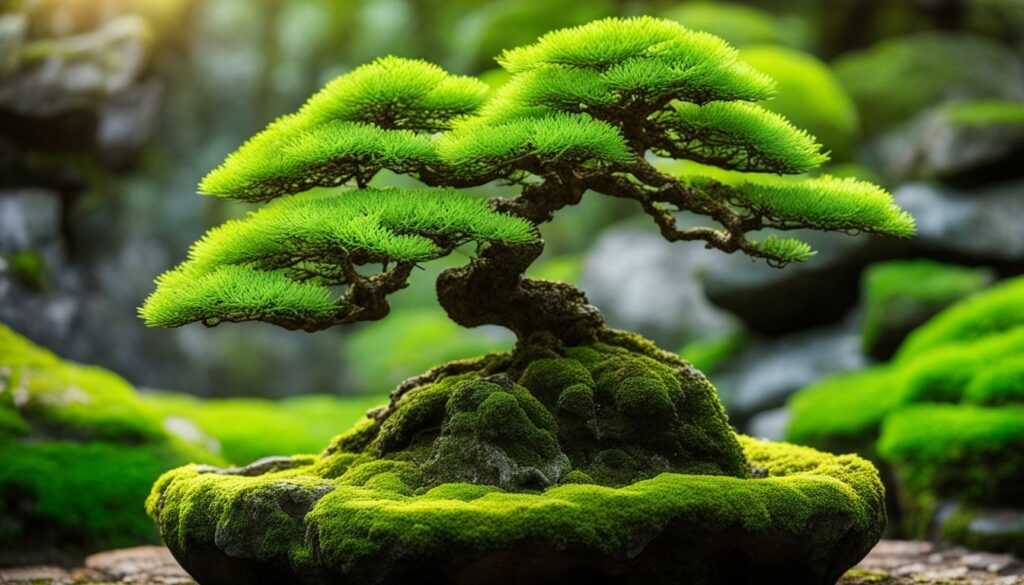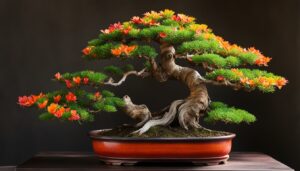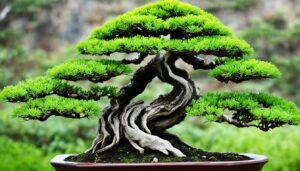If you’re looking to add a touch of natural beauty and serenity to your bonsai tree, then incorporating moss and ground cover is a perfect place to start. By introducing these organic elements, you can create an aesthetically pleasing environment for your bonsai that will also provide health benefits and protection from the elements.
This article will guide you through the process of selecting and applying different types of moss and ground cover to your bonsai, as well as providing maintenance tips to keep them thriving. Let’s explore the world of bonsai styling and learn how to create an idyllic miniature landscape.
Key Takeaways
- Adding moss and ground cover can enhance the natural beauty and serenity of your bonsai tree
- Moss has benefits for bonsai beyond its aesthetic appeal, including improved health and protection from the elements
- Choosing the right ground cover plants is crucial for maintaining the visual appeal of your bonsai’s base
- Proper preparation and maintenance are essential for ensuring the longevity of your moss and ground cover additions
- Experimenting with different combinations of moss and ground cover plants can create stunning visual effects
Benefits of Adding Moss to Bonsai
Moss has numerous benefits when it comes to enhancing the beauty and health of your bonsai. There are different types of moss that you can use, including Spanish moss, cushion moss, and sheet moss, among others. These moss types work well with bonsai and can help improve the overall look and health of your tree.
Improves Moisture Retention
Moss is a great water retainer, which is essential for the health of your bonsai. It holds moisture around the roots of your tree, allowing it to access the water as it needs it. This helps to prevent dehydration, which can cause your bonsai to wilt or die.
Provides Nutrients
Moss also provides your bonsai with essential nutrients. It absorbs nutrients from the atmosphere and releases them into the soil, where your tree can use them to grow and thrive. This natural fertilization process is much healthier for your bonsai than chemical fertilizers, which can damage the roots of your tree if not used correctly.
Enhances Aesthetic Appeal
Moss adds a beautiful touch to your bonsai, whether used as a ground cover or decorative element. It can be used to create an earthy and naturalistic look, or to add a pop of color with variations like chartreuse, lime, and neon green.
“Moss is not just a decoration; it is a way to enhance the soul and serenity of your bonsai,” says bonsai expert, David Miller.
Prevents Soil Erosion
Moss is also an effective tool in preventing soil erosion. It helps to keep the soil around the roots of your bonsai in place, reducing the likelihood of soil loss due to wind or water.
Selecting the Right Ground Cover Plants
When it comes to selecting ground cover plants for your bonsai, there are a few things to consider. First, you want to choose plants that are naturally small, as they will fit the scale of your bonsai better. Additionally, you should look for plants that complement the style of your bonsai and add visual interest to the base.
Some ground cover options that work well with bonsai include:
- Scotch Moss (Sagina subulata)
- Irish Moss (Sagina subulata ‘Aurea’)
- Miniature Stonecrop (Sedum requieni)
- Thyme (Thymus praecox)
- Miniature Ivy (Hedera helix ‘Duckfoot’)
Keep in mind that different ground cover plants have varying water and sunlight needs. Be sure to research the specific plants you select to ensure they receive the proper care.
Comparing Ground Cover Plants
| Plant Name | Sun Exposure | Water Needs |
|---|---|---|
| Scotch Moss | Partial shade to full sun | Moderate |
| Irish Moss | Partial shade to full sun | Moderate |
| Miniature Stonecrop | Full sun | Low |
| Thyme | Full sun | Low |
| Miniature Ivy | Partial shade to full sun | Low |
Choosing the right ground cover plants is crucial to elevate the look of your bonsai tree. With a well-chosen variety, the base of your bonsai can become an attractive and harmonious feature of your display.
Preparing the Bonsai for Moss and Ground Cover
Before introducing moss and ground cover to your bonsai, you need to ensure that your tree is ready to receive these additions. Here are some necessary steps to help you prepare your bonsai for the new elements:
- Assess the health of your bonsai: Moss and ground cover can thrive in a healthy environment. Check your tree for any pests, diseases or other issues that may hinder their growth.
- Clear the base of your bonsai: Remove any dead leaves or debris from the base of your tree. This step ensures that your moss and ground cover have a clean surface to grow on and provides a visually pleasing foundation for your bonsai.
- Choose the right moss and ground cover: Different moss types and ground cover plants have different growing requirements. Be sure to research the best options for your particular bonsai and climate.
- Create a suitable growing environment: Moss and ground cover thrive in a moist environment. You can achieve this by spraying your bonsai base with water or placing an appropriate saucer underneath your tree. Remember to not overwater your tree, which may cause it to rot or develop fungus.
By following these steps, you can ensure that your bonsai is ready to receive moss and ground cover. The next step is to select the appropriate moss and ground cover for your tree, which we will discuss in the following sections.
Applying Moss to Your Bonsai
Once you have prepared your bonsai with a suitable growing environment, it’s time to apply moss to the tree. The right moss type can add a significant visual appeal to your bonsai while providing various benefits. Before starting the process, ensure you have the right materials at hand, including:
- Moss
- Wire brush
- Butter knife
- Water
- Spray bottle
Choose the right type of moss for your bonsai depending on your aesthetic goals and the species of tree. You can purchase moss from a local garden center or gather it from the wild. Common moss types used for bonsai include:
- Sheet moss
- Cushion moss
- Spanish moss
- Reindeer moss
Using a wire brush, clean the surface of the bonsai where you plan to apply the moss. This will remove any debris, allowing the moss to adhere well. Next, thinly spread a layer of moss on top of the soil around the base of the tree, using a butter knife to press it down gently.
Use a spray bottle to moisten the moss, and make sure to maintain adequate moisture as the moss establishes its roots. Ensure not to overwater, as this can lead to root rot. Repeat the process until the bonsai base is fully covered with moss.
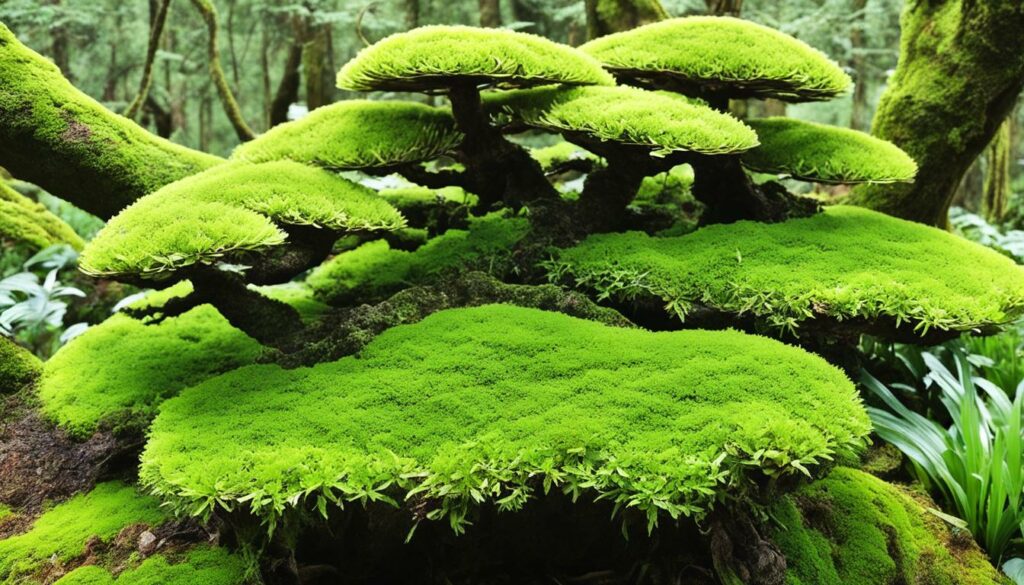
Remember, different types of moss require specific techniques for application, so always research your chosen moss type to ensure a successful outcome. Applying moss to your bonsai can significantly enhance its beauty while promoting its health and longevity.
Incorporating Ground Cover Plants
Ground cover plants are an excellent addition to your bonsai’s base. Not only do they add more beauty to your tree, but they also serve a practical purpose in preventing soil erosion. Choosing the right ground cover plants can enhance the natural and harmonious look of your bonsai.
When selecting ground cover plants, consider choosing plants that are slow-growing and have small leaves. This helps prevent them from smothering the roots of your bonsai. You can also choose plants that complement the moss you are using.
There are several ways to incorporate ground cover plants into your bonsai. You can plant them in the soil beside your bonsai, or you can use small containers and place them around the base of your bonsai.
When planting ground cover, ensure that you are not smothering the bonsai’s roots, and that the soil is well-draining. Avoid placing the ground cover too close to the trunk of the bonsai as well. You want to ensure that your bonsai has enough space to grow and thrive.
| Ground Cover Plants | Benefits |
|---|---|
| Irish Moss (Sagina subulata) | Creates a lush, green carpet; drought tolerant |
| Corsican Mint (Mentha requienii) | Creates a lovely scent; low maintenance |
| Creeping Jenny (Lysimachia nummularia) | Fast growing; vibrant chartreuse color |
| Japanese Moss (Scleranthus biflorus) | Small, moss-like growth; drought tolerant; low maintenance |
Avoid using ground cover plants that require a lot of water, as this can negatively affect the health of your bonsai. You should also avoid using invasive plants that might damage the roots of your bonsai or compete with its nutrients.
Integrating ground cover plants into your bonsai’s base can be a beautiful and rewarding addition. It’s important to do your research, choose the right plants, and provide them with the appropriate care to ensure they thrive alongside your bonsai.
Maintaining Moss and Ground Cover
To ensure your bonsai remains visually appealing, it’s essential to maintain the moss and ground cover. Here are some tips for long-term care:
Moss Maintenance
Watering: Regularly mist the moss to keep it hydrated. Avoid overwatering, as excessive moisture can cause rotting.
Trimming: Trim any yellow or brown parts of the moss to maintain its vibrancy.
Replacing: Over time, moss may become discolored or die. If this happens, remove the dead moss and replace it with fresh, healthy moss.
Fertilizing: Moss doesn’t require fertilizers, but you can lightly spray it with a diluted fertilizer solution to give it a growth boost.
Ground Cover Maintenance
Watering: Water the ground cover regularly, but don’t overwater. Make sure the soil around the bonsai is well-draining.
Trimming: Trim any overgrown or unwanted parts of the ground cover to maintain its shape.
Replacing: If the ground cover starts to die or becomes discolored, remove it and replace with healthy ground cover plants.
Fertilizing: Ground cover plants benefit from organic fertilizers. Use a balanced fertilizer in the growing season to encourage healthy growth.
Regular maintenance of moss and ground cover will ensure that your bonsai looks beautiful year-round.
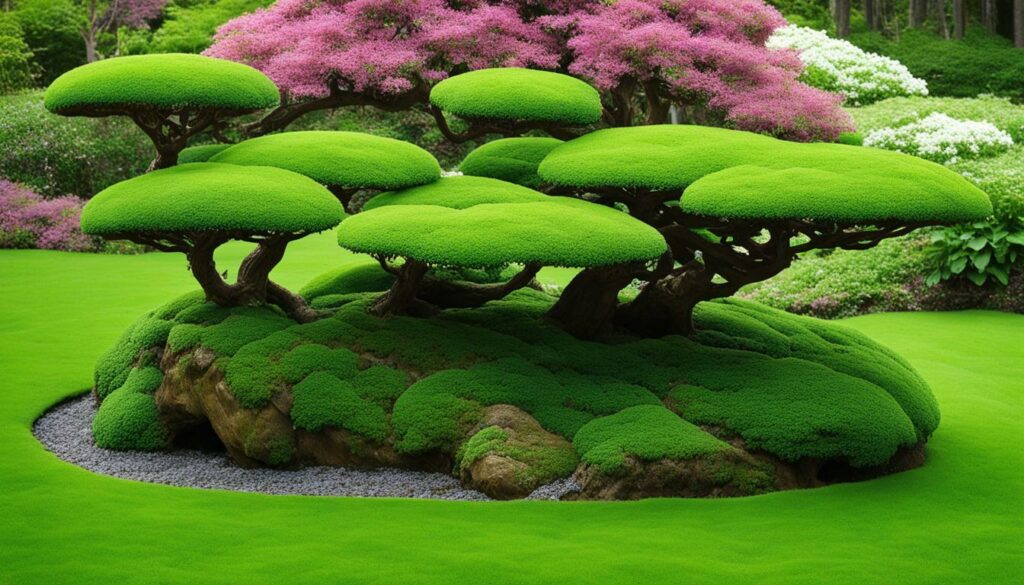
Seasonal Considerations
When incorporating ground cover plants and moss into your bonsai, it’s essential to consider the effects of seasonal changes. Different seasons may require different types of care and maintenance to ensure the healthy growth of your bonsai, moss, and ground cover plants.
During the summer months, you may need to water your bonsai more frequently due to high temperatures and increased evaporation. The hot weather may also cause ground cover plants to grow more quickly, requiring more frequent trimming and maintenance.
During the winter months, frost and snow may damage or kill certain types of ground cover plants, making it necessary to protect them with a layer of mulch or other protective coverings. Moss, on the other hand, tends to thrive in cooler temperatures and higher humidity levels.
By taking the necessary seasonal considerations into account, you can ensure the sustainable growth and survival of your bonsai, moss, and ground cover plants.
Troubleshooting Common Issues
Despite your best efforts, moss and ground cover plants may experience issues that can threaten their growth and the overall aesthetics of your Bonsai. Below are some common problems you may encounter:
Mold and Fungal Growth
Excessive moisture, especially in warm and humid environments, can cause mold and fungal growth on your moss and ground cover plants. To remedy this issue, you can:
- Reduce watering intervals and ensure proper drainage
- Apply a fungicide to combat the fungus
- Remove affected moss and replace with new growth
Yellowing and Browning of Moss
If your moss is turning yellow or brown, it may be due to overexposure to sunlight or lack of moisture. To fix this:
- Relocate your Bonsai to a better shaded area
- Rehydrate your moss by spraying it with water
- Adjust your watering schedule to ensure your moss receives adequate moisture
Root Rot
Overwatering can lead to root rot in your ground cover plants. Symptoms include yellowing leaves and stunted growth. To resolve this, you should:
- Check for signs of root rot, such as slimy and discolored roots
- Remove affected roots and repot your ground cover plant
- Reduce watering frequency and ensure proper drainage
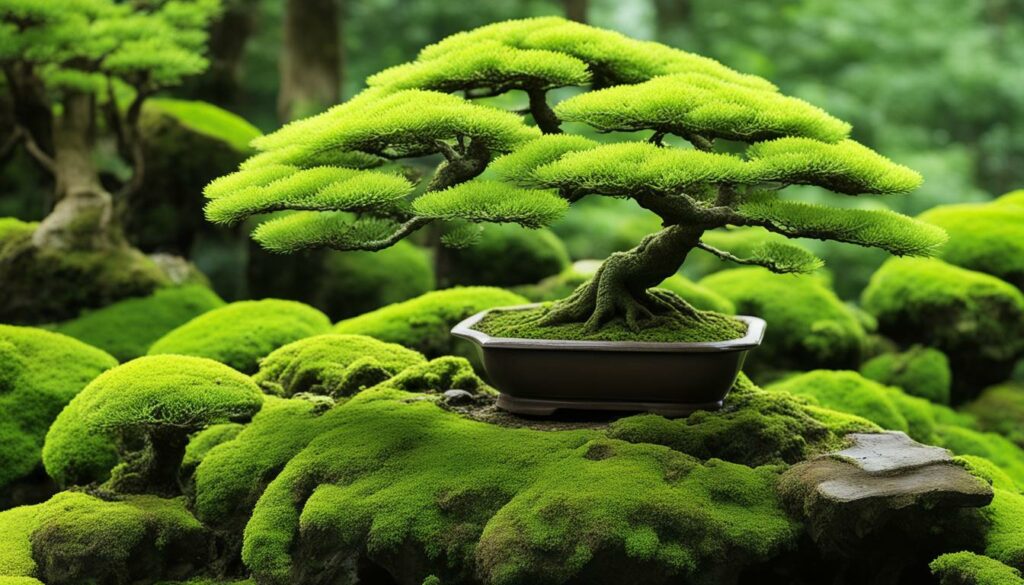
Enhancing Base Aesthetics
Perfecting the base of your bonsai is crucial for achieving a polished and refined look. Incorporating moss and ground cover is a great way to enhance the base aesthetics of your bonsai. When selecting the right elements, it’s essential to consider the color, texture, and overall harmony with your bonsai tree.
The texture of moss can add depth and dimension, while the colors of ground cover plants can create a beautiful contrast. By strategically placing these elements and selecting complementary colors and textures, you can create a stunning and natural-looking base for your bonsai tree.
An Ideal Combination of Moss and Ground Cover
For a visually engaging and natural-looking base, consider using a combination of Sphagnum moss with dwarf mondo grass. The dark green leaves of the mondo grass create a striking contrast with the light texture of the moss, making the base of your bonsai stand out.
| Moss | Ground Cover |
|---|---|
| Sphagnum moss | Dwarf mondo grass |
When selecting moss and ground cover, always consider the unique requirements of your bonsai tree. Ensure that the chosen base elements are suitable for your tree’s specific needs, maintaining a healthy environment for your bonsai.
Moss and Ground Cover Combinations
Enhance your bonsai aesthetic by experimenting with different moss and ground cover plant combinations. The possibilities are endless, and the results can be stunning. Below are some combinations that you can try:
Moss and Clover
Combining green sheet moss with white Dutch clover can add a striking contrast to your bonsai base. Sheet moss’s velvety texture beautifully complements the clover’s small white flowers, creating a serene and naturalistic look.
Moss and Sedum
Sedum plants, with their tiny star-shaped flowers, can create a delightful contrast when combined with moss. Adding creeping sedum to the sides of your bonsai pot provides an appealing pop of color that complements the tranquil green of moss.
Moss and Grasses
Mixing moss and grasses can provide a striking visual effect. Combining cushion moss with ornamental grasses adds texture and height to your bonsai’s base. The complementary hues of the two elements also contribute to a harmonious appearance in your bonsai composition.
| Combination | Description | Image |
|---|---|---|
| Moss and Clover | Green sheet moss and white Dutch clover | 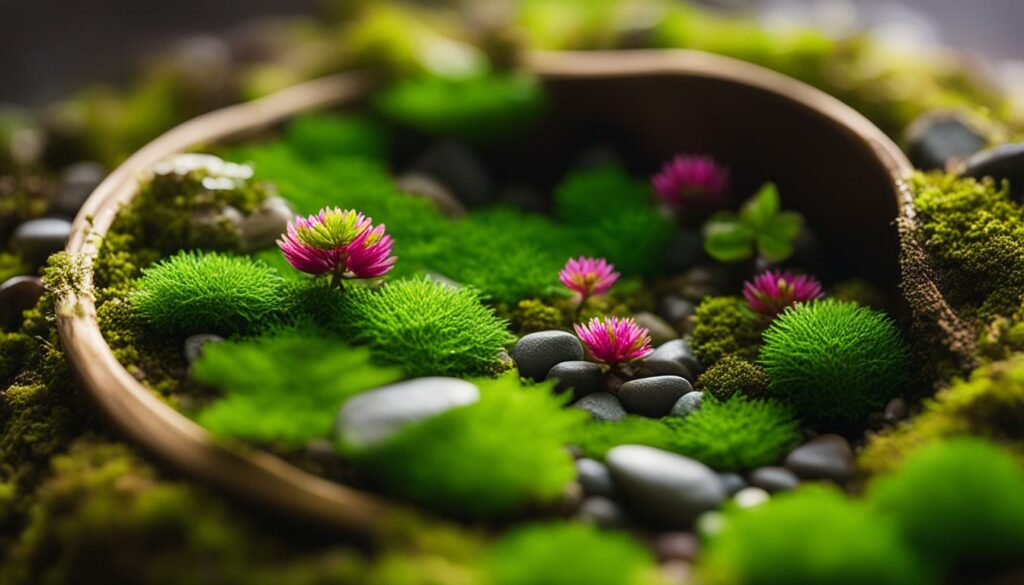 |
| Moss and Sedum | Sheet moss and creeping sedum | |
| Moss and Grasses | Cushion moss and ornamental grasses | 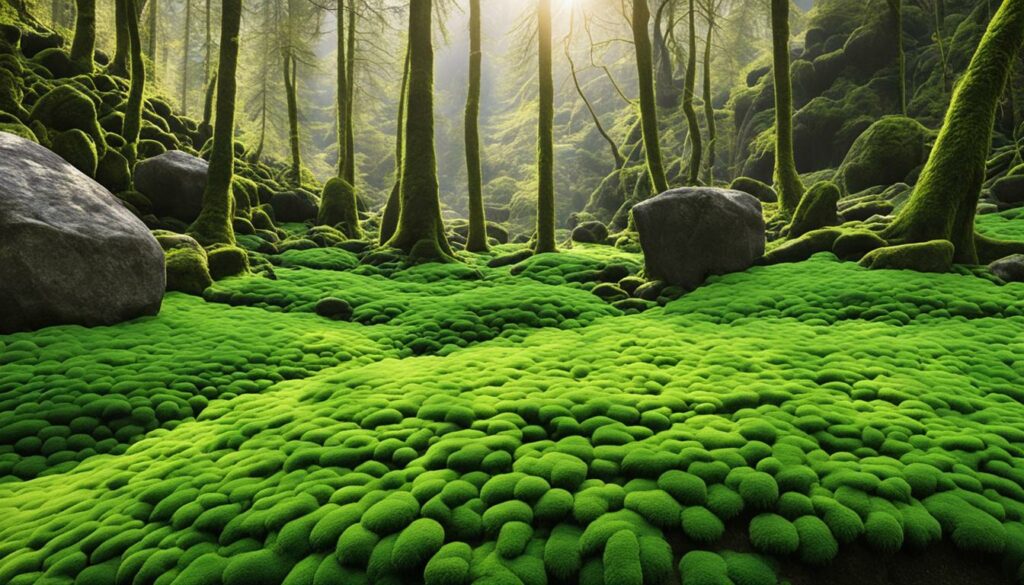 |
Ultimately, the moss and ground cover plant combinations that you choose will depend on your preferences and the aesthetic you want to create. Experimenting with different combinations can provide a satisfying and meaningful experience in your bonsai styling journey.
Ornamental Moss Arrangements
Adding moss to your bonsai provides you with an opportunity to create a unique and artistic arrangement that will make your bonsai stand out. Consider playing around with different moss types to create an aesthetically pleasing and visually engaging setup.
Moss can be arranged creatively in various ways to create unique designs that will bring your bonsai to life. One way to do this is to create shapes or figures using the moss. For example, you can create a heart-shaped pattern to add a romantic touch to your bonsai.
Another way to incorporate moss is by adding multiple layers of different moss types. This not only adds texture but also creates an eye-catching contrast that can improve your bonsai’s overall look.
You can also enhance your bonsai by incorporating other elements such as rocks, pebbles, or even a small figurine to complement the moss arrangement.
Pro tip: When using different moss types, make sure to choose varieties that contrast in color and texture, creating a distinctive pattern that highlights each moss type’s unique characteristics.
Moss Arrangements How-To
To create an ornamental moss arrangement for your bonsai, you’ll need to follow these steps:
- Select the moss types you’d like to use
- Arrange the moss on a small tray or container
- Cut the moss to fit the shape of the container
- Use a misting bottle to dampen the moss
- Place the moss arrangement carefully on the bonsai tree’s base
By following these simple steps, you can create an amazing moss arrangement that will add an artistic and creative touch to your bonsai.
Ground Cover for Erosion Control
Ground cover plants serve not only an aesthetic but practical purpose as well. They can be useful in erosion control by stabilizing the soil on slopes or areas with low water retention. By adding ground cover plants around your bonsai, you can reduce the risk of soil erosion and provide additional environmental benefits.
There are several suitable ground cover options when it comes to bonsai styling. Some recommended ground cover plants for erosion control include:
| Plant Name | Benefits |
|---|---|
| Clover | Fast-growing with deep roots |
| Thyme | Drought-resistant with aromatic leaves |
| Stonecrop | Succulent with water-retentive leaves |
Ensure that the ground cover plants chosen will thrive in the environment of your bonsai. For example, if your bonsai is located in a shaded area, choose a ground cover plant that can tolerate less sunlight.
By choosing the right ground cover options for erosion control, you can create a sustainable and visually stunning environment for your bonsai.
Showcasing the Beauty of Moss and Ground Cover
Now that you’ve learned about the benefits of incorporating moss and ground cover into your bonsai, it’s time to see the captivating beauty these elements can bring. Below are some stunning examples of bonsai trees enhanced with moss and ground cover:
Bonsai with Creeping Thyme and Irish Moss
This bonsai tree is adorned with Creeping Thyme and Irish Moss, creating a lush base that perfectly complements the tree’s delicate branches. The combination of the two types of moss gives the appearance of a forest floor, adding an extra touch of tranquility to this stunning bonsai.
Bonsai with Sheet Moss and Corsican Mint
Sheet Moss and Corsican Mint come together to create a stunningly textured base for this bonsai tree. The mint adds a fresh scent to its surroundings, while the sheet moss adds depth and natural beauty. The combination of the two plants is a feast for the senses.
Bonsai with Baby Tears and Spanish Moss
This bonsai tree has a base made of Baby Tears and Spanish Moss, creating a soft and whimsical appearance. The Spanish Moss drapes over the sides of the pot, giving the bonsai an ethereal quality. The combination of the two plants adds a touch of playful charm to this incredible work of art.
Incorporating moss and ground cover into your bonsai tree can create a serene and visually appealing masterpiece. Get inspired by these examples and start experimenting with different moss types and ground cover plants to create your own unique bonsai masterpiece.
Conclusion
Enhancing your bonsai with moss and ground cover is a great way to elevate its beauty. Not only will it create a visually appealing aesthetic, but it also promotes the health and longevity of your tree. Remember to select the right type of moss and ground cover plant, and prepare your bonsai before applying the moss and ground cover.
Proper maintenance is crucial for preserving the appeal of your bonsai. Take into consideration the seasonal requirements of both moss and ground cover plants to ensure their longevity. In case of any issues, refer to our troubleshooting section.
Experiment with different combinations of moss and ground cover plants to create a unique base for your bonsai. You can also leverage ornamental moss arrangements to add an artistic touch. Remember to enjoy the process and showcase the beauty of your bonsai tree enhanced with moss and ground cover.
We hope this guide has been helpful in your bonsai styling journey. Incorporating moss and ground cover can be an excellent addition to your bonsai’s aesthetic, and we hope this guide has provided valuable insights and inspiration to create your own masterpiece.
Thank you for reading, and happy Bonsai Styling Moss and Ground Cover!
FAQ
What are the benefits of adding moss to bonsai?
Moss not only adds a beautiful touch to your bonsai, but it also helps retain moisture, prevents soil erosion, and promotes a healthy microclimate for the tree.
How do I select the right ground cover plants for my bonsai?
When selecting ground cover plants, consider factors such as the climate, sunlight requirements, growth habit, and overall aesthetic appeal. Choose plants that complement the style and size of your bonsai.
How do I prepare my bonsai for moss and ground cover?
Before adding moss and ground cover, ensure that your bonsai is in good health and the soil is adequately prepared. Clean the base of the tree, remove any debris, and create a suitable environment for the moss and plants to thrive.
How do I apply moss to my bonsai?
Applying moss involves preparing a moss slurry or using moss spores to encourage moss growth. The technique may vary depending on the moss type you choose. It’s important to ensure proper moisture and shading for successful moss establishment.
How do I incorporate ground cover plants into my bonsai’s base?
To incorporate ground cover plants, carefully select suitable species and plant them around the base of your bonsai. Take into account their growth habits, root systems, and compatibility with the bonsai tree. Consider adding a layer of well-draining soil to create a suitable planting area.
How do I maintain moss and ground cover on my bonsai?
Maintaining moss and ground cover involves regular watering, monitoring for pests and diseases, removing any unwanted plants, and adjusting the lighting and moisture levels as necessary. Avoid overwatering or excess shading to prevent issues such as moss browning or plant rot.
Are there any seasonal considerations for moss and ground cover?
Yes, moss and ground cover may require different care during various seasons. For example, during the hot summer months, providing extra shade and regular misting can help prevent moss from drying out. In colder climates, protecting ground cover plants during frost or freezing temperatures may be necessary.
What are some common issues with moss and ground cover and how can I troubleshoot them?
Common issues with moss and ground cover can include moss browning, yellowing, or issues with plant health. Troubleshooting techniques may involve adjusting the watering frequency, providing appropriate lighting conditions, and addressing any pest or disease problems.
How do moss and ground cover enhance the base aesthetics of my bonsai?
Moss and ground cover add visual interest and a naturalistic touch to the base of your bonsai. They create a more pleasing and harmonious overall appearance, blending the bonsai tree seamlessly with its surroundings.
Can I combine different types of moss and ground cover plants?
Yes, experimenting with combinations of moss and ground cover plants can create captivating visual effects. You can try using various moss types or mix different ground cover plant species to achieve a unique and dynamic composition.
Can I create ornamental arrangements with moss within and around my bonsai?
Absolutely! Moss can be creatively shaped and arranged to form ornamental displays within the bonsai’s base or around the tree trunk. You can create patterns, borders, or even miniature landscapes using different moss varieties.
Can ground cover plants serve a practical purpose in erosion control?
Yes, besides their aesthetic appeal, ground cover plants can help control soil erosion around your bonsai. Their dense growth and root systems stabilize the soil, preventing erosion caused by rain or wind, especially on slopes or in exposed areas.
Can you provide examples of bonsai enhanced with moss and ground cover?
Certainly! We have dedicated a section in this guide to showcase stunning examples of bonsai trees embellished with moss and ground cover. These examples will inspire you to unlock the full potential of your own bonsai styling.
